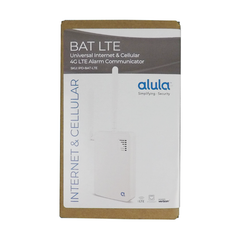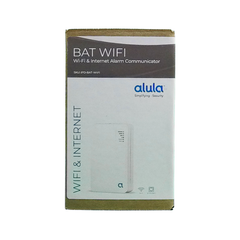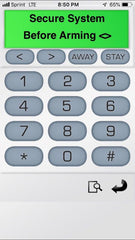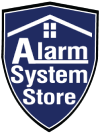
16 Sep 2019
- 0 Comment(s)
Today we’re going to be discussing Alula - Another DIY friendly option for remote control and self-monitoring with your alarm system. Alula was formerly known as IPDatatel and recently joined forces with Resolution Products who was another leader in security technology. The self-monitoring devices Alula offers are either dual path cellular and internet or internet communicators that you can add to hardwired, and some wireless alarm systems to give users their own alarm notifications and remote control of their security systems.

Alula currently offers two communicators that you can use. The first one is the IP BAT LTE Dual Path Communicator. This uses cellular and internet paths to provide users with full redundancy which means if one path fails then the other takes over so you’re not left unprotected. This unit comes with two high-gain antennae and has an RJ45 ethernet port for connection to a router. The high-gain antennae boost signal strength up to 50% to help ensure that you’ll get the best signal possible.
The IP BAT LTE is fully compatible with quite a few of the major manufacturer’s alarm panels. It is semi-compatible with others. What we mean by this is full compatibility includes the ability to deliver alarm and system notifications via email, SMS text message, or automated voice phone call plus a fully functional virtual keypad that you can access through the Alula Security app which can be downloaded from the iTunes Store or Google Play. The semi-compatibility is that the unit can be used to send the three different notification types and provide a simple keyswitch function which ends up being a one button arm/disarm feature on the Alula Security app.

The next offering from Alula is the BAT WIFI. The BAT WIFI is an internet only communicator and can be connected to a router through WIFI WPS connection or ethernet cable because of the included RJ45 port on the device itself. The BAT WIFI offers the same functionality as the IP BAT LTE so far as giving you the three notification types; email, SMS text, and automated voice phone call plus the remote control feature for arming and disarming your system via the smartphone app. These features, as before, are available fully on some systems and in limited fashion on others where you’ll only get the notifications and a simple keyswitch arming and disarming.
Now we’ll focus a little on compatibility where we’ll list which security systems these Alula communicators can be used on. The Alula devices work with three major manufacturers alarm systems. These companies are DSC, Honeywell, and Interlogix.
The DSC panels that are compatible with the IP BAT LTE and the BAT WIFI will be listed below. Some of the panels can only send you notifications while others are fully compatible for the notifications and the full virtual keypad in the Alula Security app.
| Basic Signal only | Full Support |
| PC1555 | PC1616 |
| Alexor | PC1832 |
| Impassa | PC1864 |
| Neo |
The Honeywell panels that are compatible with these two Alula devices are listed below. These panels are all fully compatible with the features that are offered as far as notifications and remote access and control. You’ll only be able to use these devices, unlike DSC, on the Honeywell hardwired systems.
|
Vista 10PSIA |
Vista 20PI |
|
Vista 128BP |
Vista 20PSIA |
|
Vista 128BPE/FB/FBPE |
Vista 21IP/IPSIA |
|
Vista 128FBP |
Vista 32FB |
|
Vista 128SIA |
First Alert FA130 |
|
Vista 15 |
First Alert FA148 |
|
Vista 15CN/P/PCN |
First Alert FA168 |
|
Vista 15PSIA |
Safewatch Pro 3000 |
The last manufacturer, Interlogix, also has panels that are fully compatible and some that are only partially compatible. Just as in the case of Honeywell; you’ll only be able to use the Alula devices on the NetworX hardwired alarm systems.
|
Basic Signal only |
Full Support |
|
Nx 4v1 |
Nx 4v2 |
|
Nx 6v1 |
Nx 6v2 |
|
Nx 8v1 |
Nx 8v2 |
|
Nx 8E |
The way that the IP BAT LTE and the BAT WIFI install into panels that have full compatibility will require wiring to the keybus terminals where you usually wire in keypads, a connection to the panel’s auxiliary power terminals, and a connection to the system’s phone line terminals. The reason for the power connections are obvious. The connection to the keybus is to provide the virtual keypad control you’ll get in the Alula Security smartphone app. The connection to the phone line terminals of the alarm system is for sending of alarm signals. This method of obtaining alarm data through those terminals is referred to as dialer capture. The alarm signals travel out of those terminals, into the cellular communicator, and out over the airwaves on their way to you or whoever else you set up in your account to receive notifications.
The semi-compatible panels that the Alula devices are used on will mainly only have two connections for phone line and power. If you have a semi-compatible system that is capable of using a keyswitch then you can also have that connection as well. On the app if you have the keyswitch function enabled at the panel you will get a simple button to push to arm or disarm the system. For the keyswitch to function your panel must have a programmable output where one wire will hook into. This programmable output looks, generally, for what state the system is in. Either armed or disarmed. The other wire will be wired to an actual zone terminal. The zone it’s hooked to will be set to be a keyswitch zone. The zone input triggers the alarm to switch between armed and disarmed.
That’s the basic wiring and setup for most panels. The Honeywell panels and DSC panels, though, can hook up two different ways. They can utilize the Telco, telephone line terminals, hook up like we mentioned above, but you can do it another way as well. For the Honeywell Vista systems you can choose to treat the Alula devices as an alternate communicator and the only hook up there would be to the power terminals and the keybus terminals. You’ll treat the programming setup differently as well. The communicator, after this other style of installation, uses the same path that a Honeywell branded cellular communicator uses. Alula does a great job of listing out all of the programming steps that need done though so you’ll know exactly what needs to be changed in the programming sections.

The DSC panels can utilize the phone line terminal hook up as we mentioned but, like the Honeywell, you can utilize another way of hook up and programming. For the DSC systems you can use their PC Link cable to hook into most of the DSC panels instead of using the phone line terminals. This is a double-ended harness cable with pin connectors and it will connect to pins on the Alula device and to pins on the DSC control board. In the DSC programming sections you’ll set this up, like the Honeywells, as an alternate communicator which means that it uses the panel’s cellular path that it usually uses for the DSC brand cellular communicators.

Once inside your account on the web portal you’ll be able to add or adjust your notification settings. You can choose to get emails, SMS text messages, automated voice calls, or all three at once. Not only can you adjust what type of notification path gets used, but you can also choose which signals trigger these notifications. You can have notifications sent for alarms, openings and closings (arming/disarming), supervisory issues, troubles, bypasses, and test signals.
You can also set aliases for users that are able to arm and disarm the system by user number. Say you have four users that have their own codes for arming and disarming the system. You can assign names to these people in-app so you know who is disarming or arming the system any time of the day. You can also set aliases for zones so when you see notifications come through you’ll see ‘Kitchen Door’ rather than ‘Zone 11’. These features will take some of the guesswork out of the equation for you to make the experience a little more streamlined. Another nice feature of the app and web portal is the ability to check past alarm history. This is referred to as the event log and list out events that have already occurred so you can go back and check things that you may have been unaware of concerning the operation of your system.
Now, most people are perfectly happy with getting their own notifications and having remote control of the system via an app, but some people would also like to have a central station monitoring package as well. That’s another great feature of the Alula devices. Not only can you use it for your own self-monitoring purposes but you can also have these devices send a signal to a central station and use professional alarm monitoring as well. Not only will you know what’s going on, but with the help of the central station, the Police, Fire, and EMS authorities will be dispatched and on route to the scene.
The Alula devices communicate using the Contact ID format so when the signals get sent to the central station they will be read out on the receiving computers at the station just like alarm signals sent by any other alarm communication device. The signals are also sent securely using an encrypted communication path.
Alula has been constantly updating and improving the way they do business and coming up with new offerings to stay up-to-date with the ever changing world of home and business security. We think that the addition of any Alula product can take your security to a new level giving you more control and freedom as far as your alarm system is concerned.

